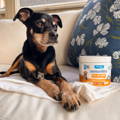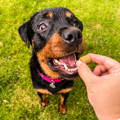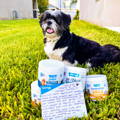10 Toxic Foods Dogs Can’t Eat for THE HOLIDAYS & BEYOND
Jump to Section

Are you preparing your home for an epic holiday feast? Be sure to double-check your shopping list for dangerous foods for dogs––those are the ones you’ll want to keep away from your pooch!
There’s no need to change your eating habits based on the foods dogs can’t eat, but it helps to be conscious of which of these foods could be pilfered by your pet. As the holidays roll around, we’re helping pet parents determine which foods are dangerous for dogs, how to tell if your dog has eaten them, and what to do if they’re ingested.
The top 10 toxic foods for dogs
1. Alcohol
2. Chocolate
In its pure form, the scientific name for chocolate is Theobroma cacao or cacao. Cacao beans are the basis for all cocoa and chocolate products. Cacao contains theobromine, a methylxanthine substance that is toxic to dogs as a stimulant and lethal when ingested in excess of 0.3 ounces per pound of a dog’s body weight.
Christmas is the second biggest holiday for chocolate sales, so it’s an important time of year to note the differences between dark and milk chocolate for your dog. Dark chocolate contains pure cacao, the most dangerous type of chocolate for your dog to consume. Milk chocolate is diluted with dairy ingredients and sugar.
White chocolate contains very low quantities of theobromine, but still contains cocoa butter, sugar, and possibly other ingredients that can cause digestive tract upset like vomiting, stool abnormalities, and reduced appetite.
The bottom line? No type of chocolate is good for your dog, but if they get a hold of dark chocolate they’ll be at higher risk for toxicity.
3. Coffee
Coffee and soda–like chocolate–contain caffeine and methylxanthines, both of which–as stimulants–are toxic to dogs. Their bodies can’t metabolize methylxanthines into usable substances, which means they can accumulate and lead to potentially deadly conditions. Caffeine is toxic in quantities of about 60 milligrams per pound of a dog's body weight, and can cause gastrointestinal upset, raise blood pressure, and cause cardiac arrhythmia (abnormal heart rhythm) in dogs.
4. Xylitol
Xylitol is an artificial sweetener and sugar alcohol found in popular keto and sugar-free foods and chewing gum. In lower amounts, xylitol and other artificial sweeteners can cause hypoglycemia (low blood sugar). When ingested in larger volumes, xylitol can cause liver damage and life-threatening liver failure in dogs.
5. Salt
Salt and salty foods are dangerous for dogs because they can cause extreme thirst and dehydration. Salt also pulls water into the digestive tract, which can cause diarrhea, electrolyte, and other nutrient loss. Sodium poisoning is an advanced–and very dangerous–side effect of feeding salt to dogs.
6. Citrus
While not necessarily life-threatening, citrus fruits are still undeniably dangerous foods for dogs. The peels, stems, and seeds of citrus fruits have high concentrations of citric acid, which can cause gastrointestinal distress like stomach pain, vomiting, reduced appetite, and abnormal stool.
7. Grapes
Another fruit on the naughty list is the grape, as well as its wrinkly counterpart, the raisin. Grapes–especially fresh grapes–are high in tartaric acid, which has recently been proven to be harmful to dogs when ingested. Vomiting and diarrhea and the first signs of toxicity, which can lead to more serious complications like kidney damage if left untreated.
8. Raw meat
Undercooked animal byproducts are more likely to harbor pathogens that cause foodborne illnesses like Salmonella, Listeria, and E. coli. For pet parents who choose to feed their dogs a raw food diet, proper food handling and storage are key for avoiding serious side effects like food poisoning and gastrointestinal distress.
9. Bones
Decades of depictions in popular media have fooled us into thinking that bones are meant to be consumed by dogs. In reality, animal bones can increase life-threatening risks of choking, intestinal obstructions, and internal injuries from bone splinters. Smaller bones from poultry and fish can be especially deadly for dogs since they’re more likely to be eaten in bigger pieces instead of being chewed thoroughly before swallowing.
10. Garlic
This pungent vegetable is a popular ingredient in people food, as are other items in the Allium family: onions, chives, shallots, and leeks. All Allium family members are considered foods dogs can’t eat; they contain substances called organosulfoxides that damage red blood cells, can cause anemia (low red blood cell counts), and impact digestive health in dogs.
These are more foods that are dangerous for dogs, depending on the volume consumed and the animal’s overall health:
- Macadamia nuts
- Avocados
- Dairy products (milk, butter, cheese)
- Almonds
- Pecans
- Walnuts
- Coconuts (coconut oil, coconut meat)
- Yeasted dough
- Mushrooms
- Broccoli
- Seeds and pits
- Ham (and other processed meats with nitrates and nitrites)
- Spicy foods

Has your dog eaten something toxic?
When any foods dogs can’t eat are in the household, you’ll want to know how to spot a dangerous–even life-threatening–reaction immediately. Symptoms like vomiting and seizures can be terrifying for you to witness and even scarier for your pet to experience!
Know the signs that your dog has ingested dangerous food so that you can take action quickly! Keep an eye out for:
Coughing/hacking
A hacking cough might be seen and heard in a dog's efforts to get rid of food items (like bones) that have obstructed their esophagus (food pipe) or trachea (windpipe).
Stomach pain
If a toxic food causes digestive upset, dogs may suffer from stomach pain, bloating, and abdominal discomfort. Stomach pain can also cause behavior changes like lethargy, not wanting to be touched, isolation, or even aggression.
Vomiting
Food poisoning is one of the most common reasons for vomiting in dogs, but can also be caused by acid reflux from highly acidic foods like citrus.
Diarrhea
An inflamed gastrointestinal tract and ingestion of toxic food can cause dog diarrhea. Many toxic foods can’t be metabolized by a dog’s system, which means the body will attempt to clear the toxin from the body as quickly as possible as it is broken down and moves through the digestive tract.
Diarrhea affects the large bowel diarrhea (colitis) category and can have clinical signs like soft to liquid consistency, small to large volume, the presence of blood and/or mucus, urgency, straining, flatulence (farting), and more.
Tremors or seizures
Certain toxins and liver damage can trigger seizures or tremors in dogs. Seizures and tremors are both identified by involuntary shaking or jerking of dogs’ body parts, most commonly the legs and extremities. Seizures are a sign that a toxin has disrupted a dog’s normal brain activity, leading to abrupt and involuntary muscle tremors.

What to do if your dog eats something they shouldn’t
What should you do if your dog has eaten something toxic? Experts recommend a careful plan of action to keep your dog stable until you can seek veterinary care:
- Check your dog’s breathing and alertness to gauge if they’re conscious.
- Remove the toxin in question (or what you assume caused the reaction) and make sure your dog can no longer get to it.
- Keep the toxin remnants in a water-tight bag or container so that your veterinarian can assess the substance(s) as part of your dog's medical evaluation.
- Contact your veterinarian, local animal hospital, the Pet Poison Helpline at 855-764-7661, or ASPCA Animal Poison Control at 888-426-4435 for guidance while you monitor your pet.
- If symptoms occur or worsen, head to your nearest available general practice or emergency/specialty hospital for immediate treatment.
How to avoid dangerous foods for dogs
It can be tough to outsmart a counter-surfing dog––especially during the busy holiday season when the house is fuller and more distracting than usual.
1. Keep dangerous foods out of reach
Pay attention to how high and how far your dog can reach when tempted. Get in the habit of pushing serving plates and other human food as far back from the edges of tables and countertops as possible to deter your dog from attempting to nab a bite.
2. Cover dangerous foods
Use a heavy lid, foil, or cling wrap to cover foods that your dog might be able to reach. Be sure to cinch the edges of plastic wrap or foil around the edges of each plate to deter nudging noses.
3. Dispose of people food safely
When disposing of holiday or everyday foods–especially those that are dangerous for dogs to eat–make sure to do so in a manner that restricts dogs' access to garbage bags, cans, or other means of disposal.
Digestive tract abnormalities that align with starting a new probiotic supplement will help you find the right CFU dose, strain, and overall best dog probiotics for your pet.
4. Keep dogs in another room
This piece of advice is especially helpful if you’re hosting a less formal dining experience. Your guests might leave food on coffee tables and other easy-to-reach areas where it’s easy for your dog to eat table scraps.
5. Keep your dog well-fed
A dog’s instincts are the main reason why they snatch human food in the first place. The best way to reduce temptation is by feeding your dog a nutritiously satisfying meal right before human food is served.
Making your house a safe space for your dog can ensure their safety and protect your peace of mind. By knowing which foods are dangerous for dogs and how to spot toxicity symptoms, you’ll be better equipped to handle a high-risk incident that could endanger your best fur-iend!
Join the Pack!

Sign up for exclusive deals, curated pet tips from veterinarians, and product launches!
Pet Parents are Also Reading...
October, 2022
Related Articles
























